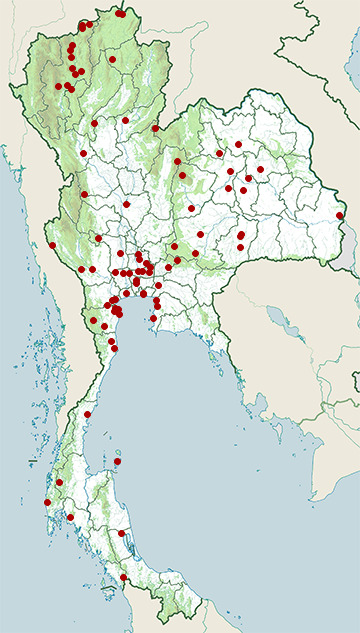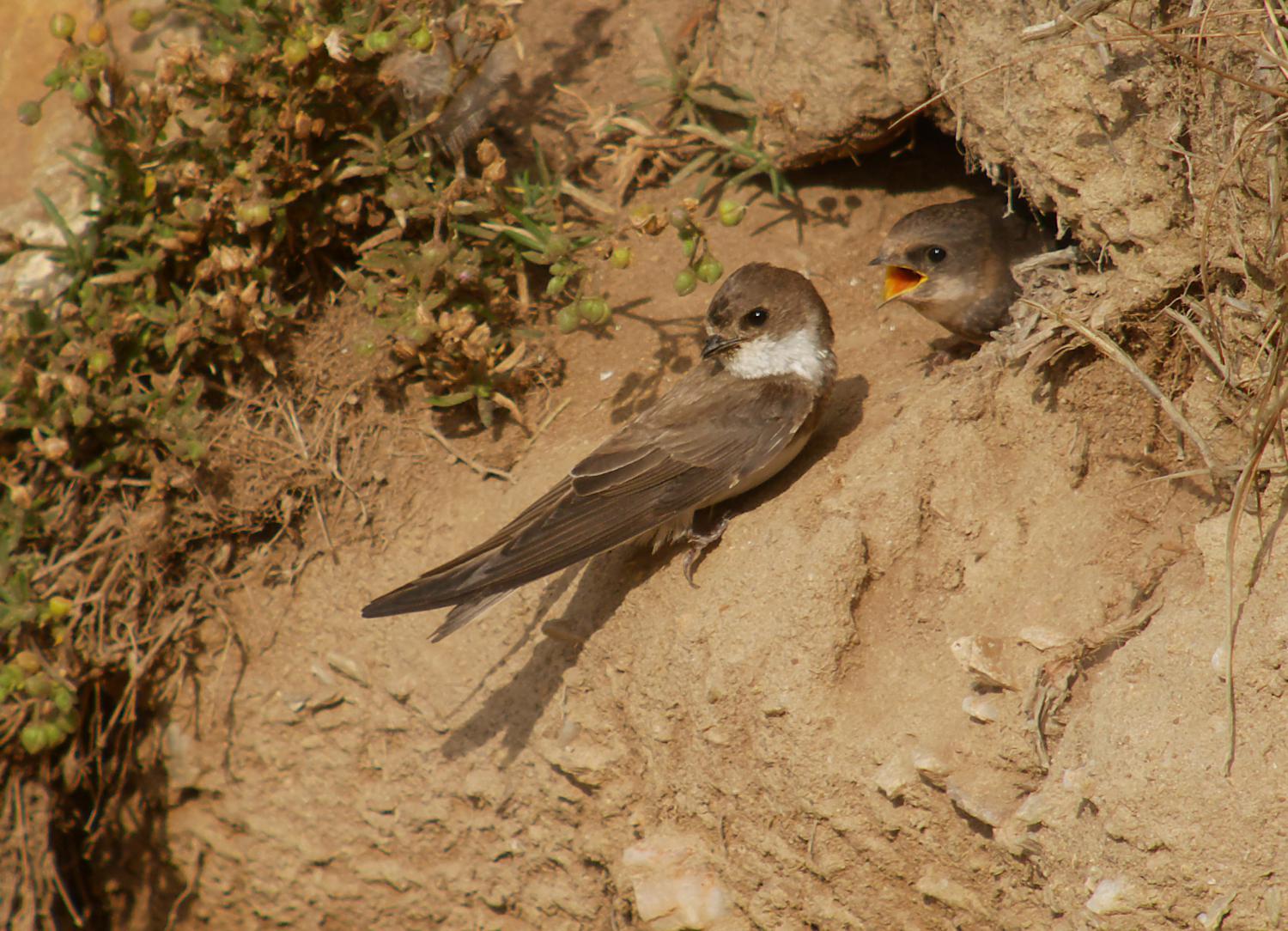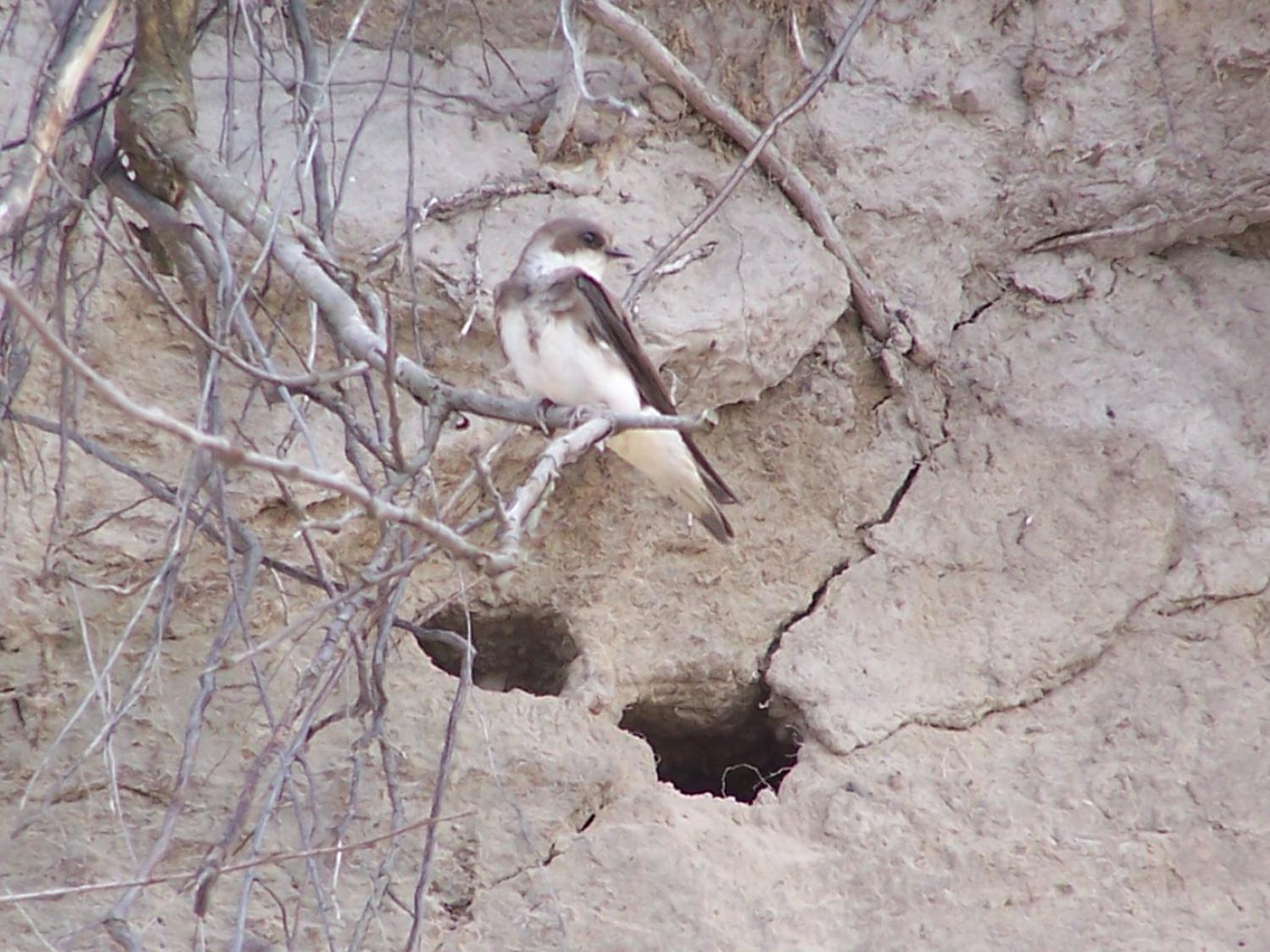Species of Thailand
Collared sand martin
Riparia riparia
Carolus Linnaeus, 1758
In Thai: นกนางแอ่นทรายสร้อยคอดำ
The sand martin (Riparia riparia) or European sand martin, bank swallow in the Americas, and collared sand martin in India, is a migratory passerine bird in the swallow family. It has a wide range in summer, embracing practically the whole of Europe and the Mediterranean countries and across the Palearctic to the Pacific Ocean. It is a Holarctic species also found in North America. It winters in eastern and southern Africa, South America, and the Indian Subcontinent.
Taxonomy
This species was first described by Carl Linnaeus in his 1758 10th edition of Systema Naturae, and originally named Hirundo riparia; the description consisted of the simple "H cinerea, gula abdomineque albis" – "an ash-grey swallow, with white throat and belly" – and the type locality was simply given as "Europa". The specific name means "of the riverbank"; it is derived from the Latin ripa "riverbank".
The pale martin of northern India and southeastern China is now usually split as a separate species Riparia diluta. It has paler grey-brown upperparts and a less distinct breast band. It winters in Pakistan and southern India.
Description
The 12 cm long sand martin is brown above, white below with a narrow brown band on the breast; the bill is black, the legs brown. The young have rufous tips to the coverts and margins to the secondaries.
Its brown back, white throat, small size and quick jerky flight separate it at once from similar swallows, such as the common house martin (Delichon urbicum), the American cliff swallow (Petrochelidon pyrrhonota) or other species of Riparia. Only the banded martin (R. cincta) of sub-Saharan Africa is similar, but the sand martin only occurs there in (the northern) winter.
The sand martin's twittering song is continuous when the birds are on the wing and becomes a conversational undertone after they have settled in the roost. The harsh alarm is heard when a passing falcon, crow or other suspected predator requires combined action to drive it away.
Ecology
Linnaeus already remarked on this species' breeding habits: Habitat in Europae collibus arenosis abruptis, foramine serpentino—"it lives in Europe, in winding holes in sheer sandy hills". It has been observed that sand martins favour loess as a particular type of ground to nest in. Sand martins are generally found near larger bodies of water, such as rivers, lakes or even the ocean, throughout the year.
In Britain, the sand martin appears on its breeding grounds as the first of its family, starting towards the end of March, just in advance of the barn swallow. In northern Ohio, they arrive in numbers by mid-April, about 10 days earlier than they did 100 years ago. At first, they flit over the larger bodies of water alone, in search of early flies. Later parties accompany other swallow species, but for a time, varying according to weather, the birds remain at these large waters and do not visit their nesting haunts. The sand martin departs early, at any rate from its more northerly haunts. In August, the gatherings at the nightly roost increase enormously, though the advent and departure of passage birds causes great irregularity in numbers. They are essentially gone from their breeding range by the end of September.
The food consists of small insects, mostly gnats and other flies whose early stages are aquatic.
The sand martin is sociable in its nesting habits; from a dozen to many hundred pairs will nest close together, according to available space. The nests are at the end of tunnels of from a few inches to three or four feet in length, bored in sand or gravel. The actual nest is a litter of straw and feathers in a chamber at the end of the burrow; it soon becomes a hotbed of parasites. Four or five white eggs are laid about mid-late May, and a second brood is usual in all but the most northernly breeding sites.
This is not a rare bird, and it is classified as a species of least concern by the IUCN. It does have some local protections, as certain populations have declined or face threats from habitat loss and fragmentation. They are considered threatened in California, where populations exist in the Sacramento Valley and at two coastal sites, Año Nuevo State Park and Fort Funston.
This article uses material from Wikipedia released under the Creative Commons Attribution-Share-Alike Licence 3.0. Eventual photos shown in this page may or may not be from Wikipedia, please see the license details for photos in photo by-lines.
Category / Seasonal Status
Wiki listed status (concerning Thai population): Winter visitor
BCST Category: Recorded in an apparently wild state within the last 50 years
BCST Seasonal status: Non-breeding visitor
Scientific classification
- Kingdom
- Animalia
- Phylum
- Chordata
- Class
- Aves
- Order
- Passeriformes
- Family
- Hirundinidae
- Genus
- Riparia
- Species
- Riparia riparia
Common names
- English:
- Common sand martin
- Sand martin
- Bank swallow
- Thai: นกนางแอ่นทรายสร้อยคอดำ
Synonyms
- Hirundo riparia, Carolus Linnaeus (1758)
- Riparia diluta
Conservation status

Least Concern (IUCN3.1)
Photos
Please help us review the bird photos if wrong ones are used. We can be reached via our contact us page.
Range Map

- Amphawa District, Samut Songkhram
- Ban Laem District, Phetchaburi
- Ban Phai District, Khon Kaen
- Bang Lamung District, Chonburi
- Bang Len District, Nakhon Pathom
- Bang Pahan District, Phra Nakhon Si Ayutthaya
- Bang Phra Non-Hunting Area
- Bang Pu Recreation Centre
- Bangkok Province
- Borabue District, Maha Sarakham
- Bueng Boraped Non-Hunting Area
- Chatturat District, Chaiyaphum
- Chiang Dao District, Chiang Mai
- Chiang Dao Wildlife Sanctuary
- Chiang Saen District, Chiang Rai
- Dan Chang District, Suphan Buri
- Doi Inthanon National Park
- Doi Lo District, Chiang Mai
- Doi Pha Hom Pok National Park
- Doi Saket District, Chiang Mai
- Fang District, Chiang Mai
- Huai Chorakhe Mak Reservoir Non-Hunting Area
- Kaeng Krachan National Park
- Kamphaeng Saen District, Nakhon Pathom
- Kantharawichai District, Maha Sarakham
- Khao Dinsor (Chumphon Raptor Center)
- Khao Sam Roi Yot National Park
- Khao Sok National Park
- Khao Yai National Park
- Khao Yoi District, Phetchaburi
- Khlong Luang District, Pathum Thani
- Ko Samui District, Surat Thani
- Kumphawapi District, Udon Thani
- Laem Pak Bia
- Mae Ai District, Chiang Mai
- Mae Rim District, Chiang Mai
- Mae Taeng District, Chiang Mai
- Mae Wong National Park
- Mueang Buriram District, Buriram
- Mueang Chachoengsao District, Chachoengsao
- Mueang Chiang Mai District, Chiang Mai
- Mueang Chonburi District, Chonburi
- Mueang Kalasin District, Kalasin
- Mueang Kanchanaburi District, Kanchanaburi
- Mueang Khon Kaen District, Khon Kaen
- Mueang Krabi District, Krabi
- Mueang Nakhon Ratchasima District, Nakhon Ratchasima
- Mueang Nonthaburi District, Nonthaburi
- Mueang Phayao District, Phayao
- Mueang Phetchaburi District, Phetchaburi
- Mueang Samut Sakhon District, Samut Sakhon
- Mueang Samut Songkhram District, Samut Songkhram
- Mueang Suphanburi District, Suphan Buri
- Mueang Tak District, Tak
- Mueang Uttaradit District, Uttaradit
- Nam Nao National Park
- Non Sang District, Nong Bua Lamphu
- Nong Bong Khai Non-Hunting Area
- Nong Suea District, Pathum Thani
- Pa Sang District, Lamphun
- Pak Chong District, Nakhon Ratchasima
- Pak Phli District, Nakhon Nayok
- Pak Thale
- Pha Taem National Park
- Phra Nakhon Si Ayutthaya District, Phra Nakhon Si Ayutthaya
- Phu Khiao Wildlife Sanctuary
- Phu Suan Sai National Park
- Pran Buri District, Prachuap Khiri Khan
- Sai Noi District, Nonthaburi
- Sai Yok District, Kanchanaburi
- Sakaerat Environmental Research Station
- Samut Prakan Province
- Sanam Bin Reservoir Non-Hunting Area
- Si Satchanalai National Park
- Tha Yang District, Phetchaburi
- Thai Mueang District, Phang Nga
- Thale Ban National Park
- Thale Noi Non-Hunting Area
- Thanyaburi District, Pathum Thani
- Thong Pha Phum National Park
- Wang Noi District, Phra Nakhon Si Ayutthaya
- Wat Phai Lom & Wat Ampu Wararam Non-Hunting Area

